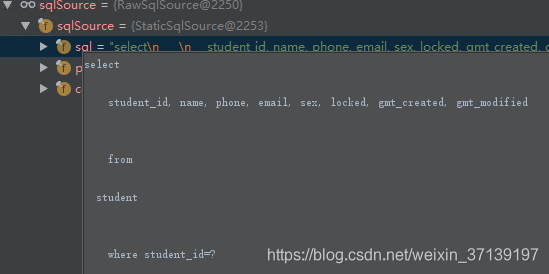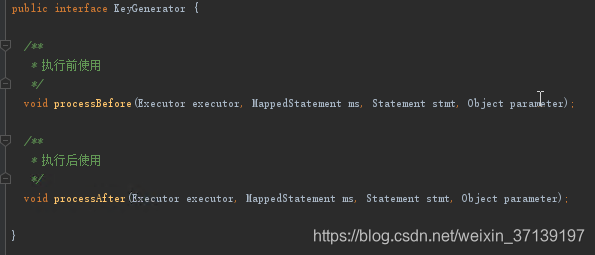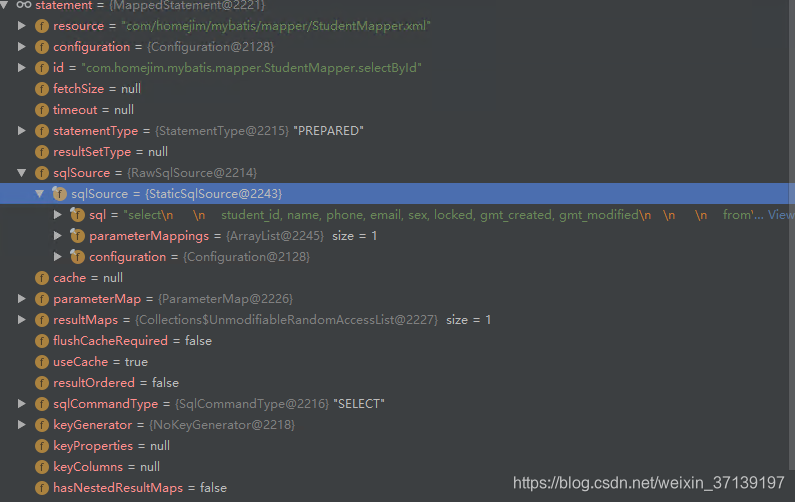0 <sql> 节点解析
在此之前, 需要先了解一下
/** * 解析 <sql> 节点 * * @param list * @param requiredDatabaseId * @throws Exception */ private void sqlElement(List<XNode> list, String requiredDatabaseId) throws Exception { // 遍历 <sql> 节点 for (XNode context : list) { // 获取 databaseId 属性 String databaseId = context.getStringAttribute("databaseId"); // 获取 id 属性 String id = context.getStringAttribute("id"); // 为 id 添加命名空间 id = builderAssistant.applyCurrentNamespace(id, false); // 检查 sql 节点的 databaseId 与当前 Configuration 中的是否一致 if (databaseIdMatchesCurrent(id, databaseId, requiredDatabaseId)) { // 记录到 XMLMapperBuider.sqlFragments(Map<String, XNode>)中保存 // 其最终是指向了 Configuration.sqlFragments(configuration.getSqlFragments) 集合 sqlFragments.put(id, context); } } }
整体的过程就是获取所有节点, 然后逐个解析。 然后以 id-> context 键值对的方式存放在 XMLMapperBuilder.sqlFragments 对象中, 后续会用到。
注意, 此时的 context 还是 XNode 对象, 其最终的解析还是在解析 include 时进行解析。
注意, id 使用了 MapperBuilderAssistant.applyCurrentNamespace 进行了处理。 其是按照一定的规则在前面添加 namespace, 以便 id 在全局具有唯一性。
1 解析流程
其整体的代码是这样子的
public void parseStatementNode() { // 获取 id 属性 String id = context.getStringAttribute("id"); // 获取 databaseid String databaseId = context.getStringAttribute("databaseId"); //验证databaseId是否匹配 if (!databaseIdMatchesCurrent(id, databaseId, this.requiredDatabaseId)) { return; } // 获取各个属性 Integer fetchSize = context.getIntAttribute("fetchSize"); Integer timeout = context.getIntAttribute("timeout"); String parameterMap = context.getStringAttribute("parameterMap"); String parameterType = context.getStringAttribute("parameterType"); Class<?> parameterTypeClass = resolveClass(parameterType); String resultMap = context.getStringAttribute("resultMap"); String resultType = context.getStringAttribute("resultType"); String lang = context.getStringAttribute("lang"); LanguageDriver langDriver = getLanguageDriver(lang); Class<?> resultTypeClass = resolveClass(resultType); String resultSetType = context.getStringAttribute("resultSetType"); StatementType statementType = StatementType.valueOf(context.getStringAttribute("statementType", StatementType.PREPARED.toString())); ResultSetType resultSetTypeEnum = resolveResultSetType(resultSetType); // 获取节点的类型 String nodeName = context.getNode().getNodeName(); SqlCommandType sqlCommandType = SqlCommandType.valueOf(nodeName.toUpperCase(Locale.ENGLISH)); boolean isSelect = sqlCommandType == SqlCommandType.SELECT; boolean flushCache = context.getBooleanAttribute("flushCache", !isSelect); boolean useCache = context.getBooleanAttribute("useCache", isSelect); boolean resultOrdered = context.getBooleanAttribute("resultOrdered", false); // Include Fragments before parsing // 引入include 解析出的 sql 节点内容 XMLIncludeTransformer includeParser = new XMLIncludeTransformer(configuration, builderAssistant); includeParser.applyIncludes(context.getNode()); // Parse selectKey after includes and remove them. // 处理 selectKey processSelectKeyNodes(id, parameterTypeClass, langDriver); // Parse the SQL (pre: <selectKey> and <include> were parsed and removed) SqlSource sqlSource = langDriver.createSqlSource(configuration, context, parameterTypeClass); String resultSets = context.getStringAttribute("resultSets"); String keyProperty = context.getStringAttribute("keyProperty"); String keyColumn = context.getStringAttribute("keyColumn"); KeyGenerator keyGenerator; // 设置主键自增的方式 String keyStatementId = id + SelectKeyGenerator.SELECT_KEY_SUFFIX; keyStatementId = builderAssistant.applyCurrentNamespace(keyStatementId, true); if (configuration.hasKeyGenerator(keyStatementId)) { keyGenerator = configuration.getKeyGenerator(keyStatementId); } else { keyGenerator = context.getBooleanAttribute("useGeneratedKeys", configuration.isUseGeneratedKeys() && SqlCommandType.INSERT.equals(sqlCommandType)) ? Jdbc3KeyGenerator.INSTANCE : NoKeyGenerator.INSTANCE; } builderAssistant.addMappedStatement(id, sqlSource, statementType, sqlCommandType, fetchSize, timeout, parameterMap, parameterTypeClass, resultMap, resultTypeClass, resultSetTypeEnum, flushCache, useCache, resultOrdered, keyGenerator, keyProperty, keyColumn, databaseId, langDriver, resultSets); }
但去除一些获取节点属性的代码, 去除一些反射的代码。 其流程可以用下图表示

2 节点解析
在其他的内容解析之前, 会先解析
先看看约束的定义
<!ELEMENT include (property+)?> <!ATTLIST include refid CDATA #REQUIRED >
可以看出,
2.1 解析流程
解析时, 通过 XMLIncludeTransformer.applyIncludes 方法进行解析。
/** * 从 parseStatementNode 方法进入时, Node 还是 (select|insert|update|delete) 节点 */ public void applyIncludes(Node source) { Properties variablesContext = new Properties(); // 获取的是 mybatis-config.xml 所定义的属性 Properties configurationVariables = configuration.getVariables(); if (configurationVariables != null) { variablesContext.putAll(configurationVariables); } // 处理 <include> 子节点 applyIncludes(source, variablesContext, false); }
获取 Coniguration.variables 中的所有属性, 这些属性后续在将 ${XXX} 替换成真实的参数时会用到。 然后递归解析所有的 include 节点。 具体的实现过程如下:
/** * Recursively apply includes through all SQL fragments. * 递归的包含所有的 SQL 节点 * * @param source Include node in DOM tree * @param variablesContext Current context for static variables with values */ private void applyIncludes(Node source, final Properties variablesContext, boolean included) { // 下面是处理 include 子节点 if (source.getNodeName().equals("include")) { // 查找 refid 属性指向 <sql> 节点 Node toInclude = findSqlFragment(getStringAttribute(source, "refid"), variablesContext); // 解析 <include> 节点下的 <property> 节点, 将得到的键值对添加到 variablesContext 中 // 并形成 Properties 对象返回, 用于替换占位符 Properties toIncludeContext = getVariablesContext(source, variablesContext); // 递归处理 <include> 节点, 在 <sql> 节点中可能会 <include> 其他 SQL 片段 applyIncludes(toInclude, toIncludeContext, true); if (toInclude.getOwnerDocument() != source.getOwnerDocument()) { toInclude = source.getOwnerDocument().importNode(toInclude, true); } // 将 <include> 节点替换成 <sql> source.getParentNode().replaceChild(toInclude, source); while (toInclude.hasChildNodes()) { toInclude.getParentNode().insertBefore(toInclude.getFirstChild(), toInclude); } toInclude.getParentNode().removeChild(toInclude); } else if (source.getNodeType() == Node.ELEMENT_NODE) { if (included && !variablesContext.isEmpty()) { // replace variables in attribute values // 获取所有的属性值, 并使用 variablesContext 进行占位符的解析 NamedNodeMap attributes = source.getAttributes(); for (int i = 0; i < attributes.getLength(); i++) { Node attr = attributes.item(i); attr.setNodeValue(PropertyParser.parse(attr.getNodeValue(), variablesContext)); } } // 获取所有的子类, 并递归解析 NodeList children = source.getChildNodes(); for (int i = 0; i < children.getLength(); i++) { applyIncludes(children.item(i), variablesContext, included); } } else if (included && source.getNodeType() == Node.TEXT_NODE && !variablesContext.isEmpty()) { // replace variables in text node // 使用 variablesContext 进行占位符的解析 source.setNodeValue(PropertyParser.parse(source.getNodeValue(), variablesContext)); } }
它分三种节点进行解析
- include
- Node.ELEMENT_NODE
- Node.TEXT_NODE
2.2 <include> 节点的解析
这个是节点为

2.3 Node.ELEMENT_NODE 类型解析
什么时候回出现这种情况呢? 节点是非
这个的流程很简单, 就是递归调用解析所有的
// 获取所有的子类, 并递归解析 NodeList children = source.getChildNodes(); for (int i = 0; i < children.getLength(); i++) { applyIncludes(children.item(i), variablesContext, included); }
2.4 Node.TEXT_NODE
Node.TEXT_NODE 就是文本节点, 当时该类型的节点时, 就会使用 PropertyParser.parse 方法来进行解析。 其大体就是将 ${xxx} 替换成相应的值。
由于有 included 条件的现在, 其只有是在 include 所包含的子节点时才会如此。
举例
该过程中涉及到了多层递归, 同时还有多种节点类型, 还需要进行占位符的处理, 理解上还是比较费劲的, 举个栗子吧
<!--全部字段--> <sql id="Base_Column_List"> student_id, name, phone, email, sex, locked, gmt_created, gmt_modified </sql> <!--表名--> <sql id="sometable"> ${table} </sql> <!--refid可以使用${}--> <sql id="someinclude"> from <include refid="${include_target}"/> </sql> <!--SQL--> <select id="selectById" resultMap="BaseResultMap"> select <include refid="Base_Column_List" /> <include refid="someinclude"> <property name="table" value="student"/> <property name="include_target" value="sometable"/> </include> where student_id=#{studentId, jdbcType=INTEGER} </select>
其流程大体如下

看的时候, 请对照代码来看, 详细讲解了前面三个节点的解析过程。 后面的类似, 可能有的递归层次加深了, 并大体的思路并没有改变。
3 节点
/** * 真正解析 selectKey 的函数 */ private void parseSelectKeyNode(String id, XNode nodeToHandle, Class<?> parameterTypeClass, LanguageDriver langDriver, String databaseId) { // 开始时获取各个属性 String resultType = nodeToHandle.getStringAttribute("resultType"); Class<?> resultTypeClass = resolveClass(resultType); StatementType statementType = StatementType.valueOf(nodeToHandle.getStringAttribute("statementType", StatementType.PREPARED.toString())); String keyProperty = nodeToHandle.getStringAttribute("keyProperty"); String keyColumn = nodeToHandle.getStringAttribute("keyColumn"); boolean executeBefore = "BEFORE".equals(nodeToHandle.getStringAttribute("order", "AFTER")); //defaults boolean useCache = false; boolean resultOrdered = false; KeyGenerator keyGenerator = NoKeyGenerator.INSTANCE; Integer fetchSize = null; Integer timeout = null; boolean flushCache = false; String parameterMap = null; String resultMap = null; ResultSetType resultSetTypeEnum = null; // 生成对应的 SqlSource SqlSource sqlSource = langDriver.createSqlSource(configuration, nodeToHandle, parameterTypeClass); SqlCommandType sqlCommandType = SqlCommandType.SELECT; // 使用 SqlSource 创建 MappedStatement 对象 builderAssistant.addMappedStatement(id, sqlSource, statementType, sqlCommandType, fetchSize, timeout, parameterMap, parameterTypeClass, resultMap, resultTypeClass, resultSetTypeEnum, flushCache, useCache, resultOrdered, keyGenerator, keyProperty, keyColumn, databaseId, langDriver, null); id = builderAssistant.applyCurrentNamespace(id, false); MappedStatement keyStatement = configuration.getMappedStatement(id, false); // 添加到 Configuration 中, 并通过 executeBefore 还觉得是在sql之前执行还是之后执行 configuration.addKeyGenerator(id, new SelectKeyGenerator(keyStatement, executeBefore)); }
其中涉及到
SqlSource sqlSource = langDriver.createSqlSource(configuration, nodeToHandle, parameterTypeClass);
这个过程。
LanguageDriver 类有两个实现类

默认是 XMLLanguageDriver。 可以通过 Configuration 的构造函数得出。
languageRegistry.setDefaultDriverClass(XMLLanguageDriver.class);
在 langDriver.createSqlSource 函数中, 会调用 parseScriptNode 函数
/** * 解析动态节点 * @return */ public SqlSource parseScriptNode() { // 首先判断是不是动态节点 MixedSqlNode rootSqlNode = parseDynamicTags(context); SqlSource sqlSource = null; if (isDynamic) { sqlSource = new DynamicSqlSource(configuration, rootSqlNode); } else { sqlSource = new RawSqlSource(configuration, rootSqlNode, parameterType); } return sqlSource; }
而其中, 需要判定是否为动态SQL, 其中, 有 $ 和动态 sql 的节点, 都会认为是动态SQL。
/** * 解析动态节点 * @param node * @return */ protected MixedSqlNode parseDynamicTags(XNode node) { List<SqlNode> contents = new ArrayList<>(); // 获取节点下的所有子节点 NodeList children = node.getNode().getChildNodes(); for (int i = 0; i < children.getLength(); i++) { // 获取节点 XNode child = node.newXNode(children.item(i)); if (child.getNode().getNodeType() == Node.CDATA_SECTION_NODE || child.getNode().getNodeType() == Node.TEXT_NODE) { // 如果有 $ , 则为动态sql节点 String data = child.getStringBody(""); TextSqlNode textSqlNode = new TextSqlNode(data); if (textSqlNode.isDynamic()) { contents.add(textSqlNode); isDynamic = true;// 标记为动态节点 } else { contents.add(new StaticTextSqlNode(data)); } } else if (child.getNode().getNodeType() == Node.ELEMENT_NODE) { // issue #628 // 子节点是标签, 则一定是动态sql节点。 根据nodeName, 生产不同的 NodeHandler String nodeName = child.getNode().getNodeName(); NodeHandler handler = nodeHandlerMap.get(nodeName); if (handler == null) { throw new BuilderException("Unknown element <" + nodeName + "> in SQL statement."); } handler.handleNode(child, contents); isDynamic = true; } } return new MixedSqlNode(contents); }
NodeHandler 有以下几个实现类

是不是似曾相识? 就是动态 SQL 的几个节点所对应的。
在该过程之后, selectById 就变成了:

4 创建 SqlSource
该过程与上面的过程相似, 经过 include 节点的解析之后, 会创建对应的 SqlSourceNode 对象。
关于 SqlSource, 会在后续的文章中详细展开讲解。
在该过程之后, selectById 变成了

对应参数及其类型被保存起来, 同时参数的占位符 #{xxx, JdbcType=yyy} 变成了问号。 在调用 RawSqlSource 构造函数时, 会完成该过程
public RawSqlSource(Configuration configuration, String sql, Class<?> parameterType) { SqlSourceBuilder sqlSourceParser = new SqlSourceBuilder(configuration); Class<?> clazz = parameterType == null ? Object.class : parameterType; sqlSource = sqlSourceParser.parse(sql, clazz, new HashMap<String, Object>()); } public SqlSource parse(String originalSql, Class<?> parameterType, Map<String, Object> additionalParameters) { // 占位符处理器 ParameterMappingTokenHandler handler = new ParameterMappingTokenHandler(configuration, parameterType, additionalParameters); GenericTokenParser parser = new GenericTokenParser("#{", "}", handler); String sql = parser.parse(originalSql); return new StaticSqlSource(configuration, sql, handler.getParameterMappings()); } // SQL 中的占位符处理。 @Override public String handleToken(String content) { parameterMappings.add(buildParameterMapping(content)); return "?"; }
5 获取对应的 KeyGenerator
KeyGenerator为键生成器。 在我们使用主键自动生成时, 会生成一个对应的主键生成器实例。

该接口主要定义了生成器的在 SQL 在查询前执行还是之后执行。 其有如下的实现类

- Jdbc3KeyGenerator:用于处理数据库支持自增主键的情况,如MySQL的auto_increment。
- NoKeyGenerator:空实现,不需要处理主键。没有主键生成器, 如不是 INSERT, 也没有使用主键生成器的时候, 就是该类型。
- SelectKeyGenerator:配置了
之后, 就是该类型。 用于处理数据库不支持自增主键的情况,比如Oracle,postgres的sequence序列。
6 创建并添加 MappedStatement
在完成以上步骤的处理之后, 通过
builderAssistant.addMappedStatement(id, sqlSource, statementType, sqlCommandType, fetchSize, timeout, parameterMap, parameterTypeClass, resultMap, resultTypeClass, resultSetTypeEnum, flushCache, useCache, resultOrdered, keyGenerator, keyProperty, keyColumn, databaseId, langDriver, resultSets);
进行 MappedStatement 对象的生成, 并添加到 Configuration 中。
以上的 selectById 最后再存在 Configuration中:











